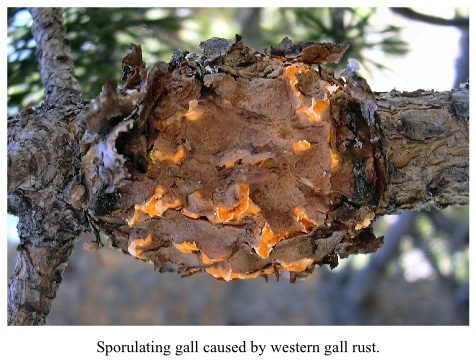PESTS AND DISEASES OF FORESTRY IN NEW ZEALAND
Beyond Borders — Forest Tree Rusts from a Global Perspective
Scion is the leading provider of forest-related knowledge in New Zealand
Formerly known as the Forest Research Institute, Scion has been a leader in research relating to forest health for over 50 years. The Rotorua-based Crown Research Institute continues to provide science that will protect all forests from damage caused by insect pests, pathogens and weeds. The information presented below arises from these research activities.
From Forest Health News 164, July 2006.
Tod Ramsfield recently attended the IUFRO meeting on Rusts of Forest Trees at Lake Tahoe, California. The theme of the meeting was “Beyond Borders — Forest Tree Rusts from a Global Perspective” and Tod was invited to present the research that he and Darren Kriticos have been conducting on the climatic suitability of New Zealand for the pathogen that causes western gall rust (Endocronartium harknessii). When originally asked to present the work, he was requested to emphasise the seriousness with which New Zealand takes biosecurity and the protection of its environment and primary industries. The Americans in the audience, living in a post-911 world, found the New Zealand viewpoint a refreshing change from what is preached by the Department of Homeland Security in the USA. The talk was well received and a few pointed remarks were made in the discussion following the presentation, including “Doesn’t the New Zealand forest industry recognise the danger of relying so heavily on Pinus radiata?”, “Is the forest industry insured in the event of a catastrophic invasion by an exotic pathogen?” and “If western gall rust does arrive, you don’t have a hope of controlling it!”.
 These are all valid questions/comments and point out how one’s own experience colours how one perceives the world. The last statement confirms why MAF and BNZ take pathway analysis and border protection so seriously.
These are all valid questions/comments and point out how one’s own experience colours how one perceives the world. The last statement confirms why MAF and BNZ take pathway analysis and border protection so seriously.
Tod also presented a talk on the risk posed by guava rust (Puccinia psidii) to Eucalyptus on behalf of colleagues in Ensis, Hobart. Most of the talks at the meeting were on Cronartium rusts of Pinus, and it was nice to present a talk on an Australian iconic species in a forum that was focused mainly on conifers. Another highlight of the meeting included a debate over the sexuality of the causal agent of western gall rust to shed light on whether Endocronartium or Peridermium is the correct genus name. Until new evidence is brought forward, this debate will continue.
After the meeting, the post-conference field tour provided an opportunity to travel into the wilds of northern California to gather more data on the distribution of western gall rust that can be used to improve the climate-matching research. The Happy Camp outplant site, where 5-needle pines with major gene resistance to Cronartium ribiciola (white pine blister rust) were being trialled, was also visited. The differences between resistant and susceptible trees were remarkable. As with all meetings, however, the most productive part of the meeting occurred over lunch and dinner where Tod got reacquainted with old friends and made new contacts from other institutions.
(Tod Ramsfield, Ensis)
This information is intended for general interest only. It is not intended to be a substitute for specific specialist advice on any matter and should not be relied on for that purpose. Scion will not be liable for any direct, indirect, incidental, special, consequential or exemplary damages, loss of profits, or any other intangible losses that result from using the information provided on this site.
(Scion is the trading name of the New Zealand Forest Research Institute Limited.)

 Farm Forestry New Zealand
Farm Forestry New Zealand

